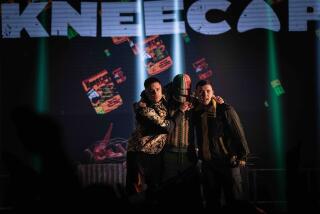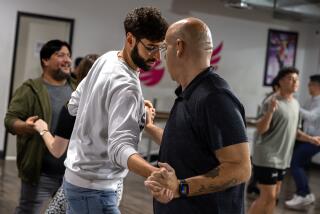You don’t have to be Irish to kick up your heels
This is one way to work off a Guinness.
Our instructor calls it a reel. There is jumping and kicking and stepping -- eight times in a circle -- and I would say it is tricky except the ponytailed pipsqueaks in my class are reeling just fine. The four adult neophytes in this Irish dance class are shipped to another room to rehearse; my friend Susannah dubs it the “loser room,” though we are both relieved. This is tough.
For the record:
12:00 a.m. March 18, 2005 For The Record
Los Angeles Times Friday March 18, 2005 Home Edition Main News Part A Page 2 National Desk 0 inches; 27 words Type of Material: Correction
Irish dance -- An article in Monday’s Health section used the term “trouble jig” to refer to a type of Irish dance. It is a “treble jig.”
For The Record
Los Angeles Times Monday March 21, 2005 Home Edition Health Part F Page 7 Features Desk 0 inches; 29 words Type of Material: Correction
Irish dance -- An article in last week’s Health section incorrectly used the term “trouble jig” to refer to a type of Irish dance. It is a “treble jig.”
As I struggle to learn Irish dance at Kristi’s Forever Dancin’ in Riverside, I am recalling a college job at Mickey Finn’s Pub in Toledo, Ohio. On the 17th of each month -- because every month deserves a St. Patrick’s Day -- servers would push back tables so prepubescent dancers in ornate green costumes could twirl. I would hoist trays piled with Bass and Boddingtons (for their parents) and try not to crash into dancers and shatter pint glasses. Their looping mesmerized: Skirts swished, feet stamped. I could do that, I thought.
Kristi’s Forever shares a plaza with insurance and mortgage companies and advertises hip-hop and cheerleading classes in neon cursive. “Attitude is a little thing that makes a BIG difference,” a banner tacked above a wall-size mirror eggs us on. A dozen people, as varied as preschoolers and parents, stand shoulder to shoulder, and Susannah asks me, “Where are we going to hide?”
We’re not. Alison Domingo, the 20-year-old instructor, pulls us to the front. She shows us part of the reel: jump-two-three, jump-two-three. It’s a steppingstone for beginners, who wear soft shoes called ghillies with crisscrossed black laces. (I’m in holey jazz shoes.) Once we’ve fumbled the jumps two or three times, Alison ushers everyone to the room’s corner for across-the-floor steps. This is better -- we can duck at the end of the line.
Another first-timer, Catherine Dong, 44, sneaks behind us. Dong adores hard-shoe Irish dancing, and her two daughters have jigged in the morning class for two or three months -- think “Riverdance” or “Lord of the Dance,” which resemble tapping. “I love the sound of pounding feet with the hard shoes. I think it’s so great to stamp,” she says. “There’s something powerful about it.” Other factors: Dong’s gym membership gathers dust. She is one-eighth Irish.
Irish dancing is intertwined with Irish history. The feis (pronounced “fesh”) -- a musical event that pulled Irish dance out of homes and under stage lights -- dates to at least the 7th and 8th centuries. Celtic people spun to bagpipe and fiddle music even during troubled times when the English frowned on Irish culture and banned pipe playing in the 1500s. Two centuries later, so-called dance masters began traveling the Technicolor-green countryside as instructors.
The Irish dance at weddings and at wakes. They dance on holidays. One man in our class plans to show off his weekly lessons at a family reunion on the Emerald Isle. Classes are offered from Los Angeles to Redlands to Yorba Linda, and while many are largely geared toward children, there’s some adult training. The Celtic Gold Academy of Irish Dance (www.celticgold.com), which runs my class, offers kids’ lessons every day and adult lessons twice a week.
About half our class is prepping for a modern-day feis, where dancers compete to live keyboards, fiddles and accordions, and vendors shill T-shirts that read “Kick Butt.” Instructors often yell this, as the legs are the dynamite of Irish dancing.
By contrast, the upper body is rigid: abs tight, fingers in fists, arms military-stiff, back rod-straight. Thighs rarely separate. At times, I feel like a plastic flamingo in a yard. After a few of us are sent to the second studio, a tiny girl with curly buns informs me that I don’t cross my legs correctly. “You look like you have to go potty,” she says. I stare at the banner that encourages, “Never settle for less than your best.”
Halfway through our 90-minute class, the students who know what they’re doing trade soft shoes for hard shoes with taps and flat toes. Dancers can balance on them like ballerinas. Domingo, who is Filipino and Italian, teaches us the appropriately named trouble jig. We rehearse briefly. For the rest of class, we watch while the other students clack and smack their feet. Music blasts from speakers, and student clomps punctuate beats. One step is called a rally, and, as I watch, I have time to notice that a woman rallying has monkeys on her socks.
Here is the catch about learning Irish dancing: It is not an instant workout. You ingest routines. You practice. You practice some more. It takes weeks or months for jigging and reeling to become “the most intense, high-impact aerobics I could imagine,” says Kevin Reilly, 31, who took the class to rehearse with his dancing daughter. In five or six months, Reilly says his endurance, flexibility and leg strength have rocketed.
When Domingo started dancing competitively, training up to four hours a week, she melted from a woman’s size 5 to a child’s size 12.
My heart rate, however, has dipped from 110 beats per minute to a resting pace during class. This is commitment exercise, not a quickie fat burn.
I calculate the calories in one pint of Guinness Stout -- about 210 -- and decide I’m not ready to rule out the reel.
*
Times staff writer Ashley Powers can be reached at ashley.powers@latimes.com.


